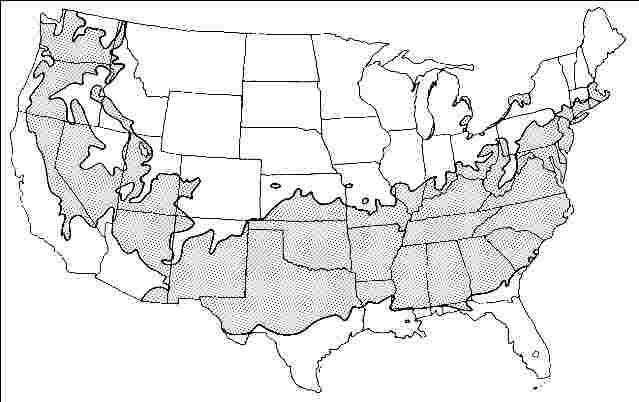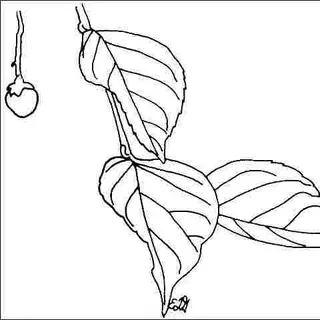Styrax japonicus 'Pink Chimes': 'Pink Chimes' Japanese Snowbell
Introduction
This cultivar of Japanese snowbell is a small deciduous tree that slowly grows from 20 to 30 feet in height and has rounded canopy with a horizontal branching pattern. With lower branches removed, it forms a more vase-shaped patio-sized shade tree. The smooth, attractive bark has orange-brown interlacing fissures adding winter interest to any landscape. The pink, bell-shaped, drooping flower clusters of 'Pink Chimes' are quite showy in May to June.

Credit: UF/IFAS
General Information
Scientific name: Styrax japonicus
Pronunciation: STY-racks juh-PAWN-ih-kuss
Common name(s): 'Pink Chimes' Japanese snowbell
Family: Styracaceae
USDA hardiness zones: 5A through 8A (Figure 2)
Origin: not native to North America
Invasive potential: not assessed/incomplete assessment
Uses: trained as a standard; parking lot island < 100 sq ft; parking lot island 100–200 sq ft; parking lot island > 200 sq ft; tree lawn 3–4 feet wide; tree lawn 4–6 feet wide; tree lawn > 6 ft wide; specimen; street without sidewalk; deck or patio; container or planter; sidewalk cutout (tree pit); highway median

Credit: UF/IFAS
Description
Height: 20 to 30 feet
Spread: 15 to 25 feet
Crown uniformity: symmetrical
Crown shape: round, vase
Crown density: moderate
Growth rate: slow
Texture: medium
Foliage
Leaf arrangement: alternate (Figure 3)
Leaf type: simple
Leaf margin: sinuate/undulate, entire, serrate
Leaf shape: oblong, elliptic (oval)
Leaf venation: pinnate, brachidodrome
Leaf type and persistence: deciduous
Leaf blade length: less than 2 inches, 2 to 4 inches
Leaf color: green
Fall color: yellow, red
Fall characteristic: not showy

Credit: UF/IFAS
Flower
Flower color: pink
Flower characteristics: showy
Fruit
Fruit shape: oval, round
Fruit length: less than 0.5 inch, 0.5 to 1 inch
Fruit covering: fleshy
Fruit color: green
Fruit characteristics: does not attract wildlife; not showy; fruit/leaves not a litter problem
Trunk and Branches
Trunk/bark/branches: branches droop; showy; typically multi-trunked; thorns
Pruning requirement: little required
Breakage: resistant
Current year twig color: green
Current year twig thickness: thin
Wood specific gravity: unknown
Culture
Light requirement: full sun, partial sun, or partial shade
Soil tolerances: clay; sand; loam; acidic; slightly alkaline; well-drained
Drought tolerance: moderate
Aerosol salt tolerance: moderate
Other
Roots: not a problem
Winter interest: yes
Outstanding tree: yes
Ozone sensitivity: unknown
Verticillium wilt susceptibility: unknown
Pest resistance: free of serious pests and diseases
Use and Management
It is an excellent small patio tree where the flowers and interesting bark can be viewed up close; however, the flowers attract tremendous numbers of bees, and one should be cautious about approaching the plant at that time. Japanese snowbell also makes a wonderful addition to the mixed shrubbery border. Due to its small stature and vase-shape, in moist soil it can make a nice street tree where overhead space is limited. The fruit is somewhat showy and may cause a small litter problem for a short time in the fall. Fall leaf color is unreliable.
Snowbell prefers a peaty, acid soil that is moist but not waterlogged. In colder areas (USDA hardiness zone 5b), locate Styrax japonicus in an area protected from winter winds. In the south (USDA hardiness zones 7 and 8) locate it so it receives only part sun during the summer to promote best growth and appearance. This cultivar displays wonderful pink flowers as far south as zone 7b (perhaps in zone 8a).
Other cultivars include: 'Carillon' grows about one-foot per year, has a weeping habit, can be staked to encourage weeping habit; 'Crystal'—upright to fastigiate habit, black green foliage, crisp white flowers with purple pedicels (zone 5); 'Issai'—cold hardy to zone 6, grows faster than species and roots easily.
Propagate by softwood cuttings in summer.
Pests and Diseases
No pests or diseases of major concern except ambrosia beetle which can infest stressed trees. It is almost pest free.



